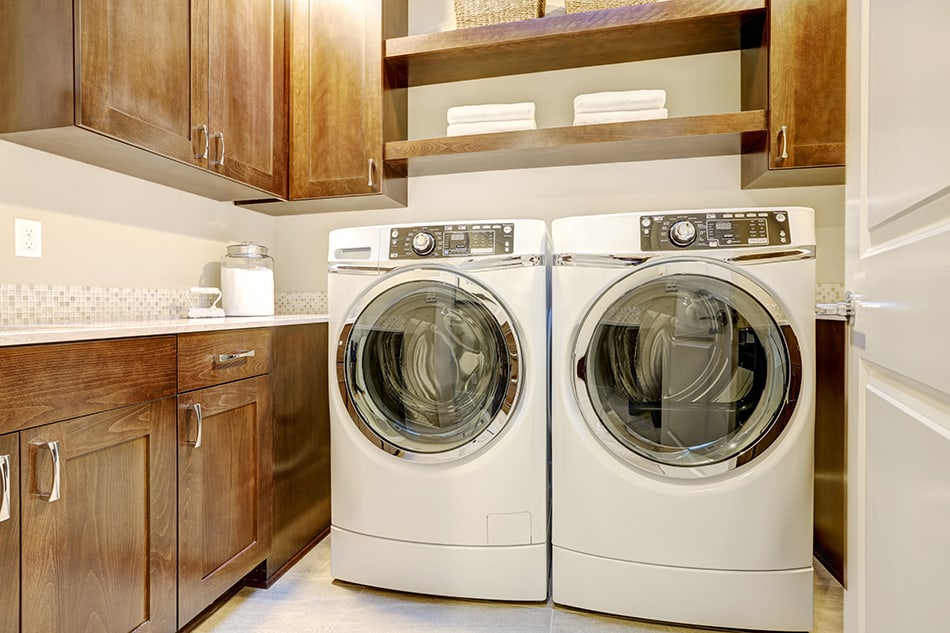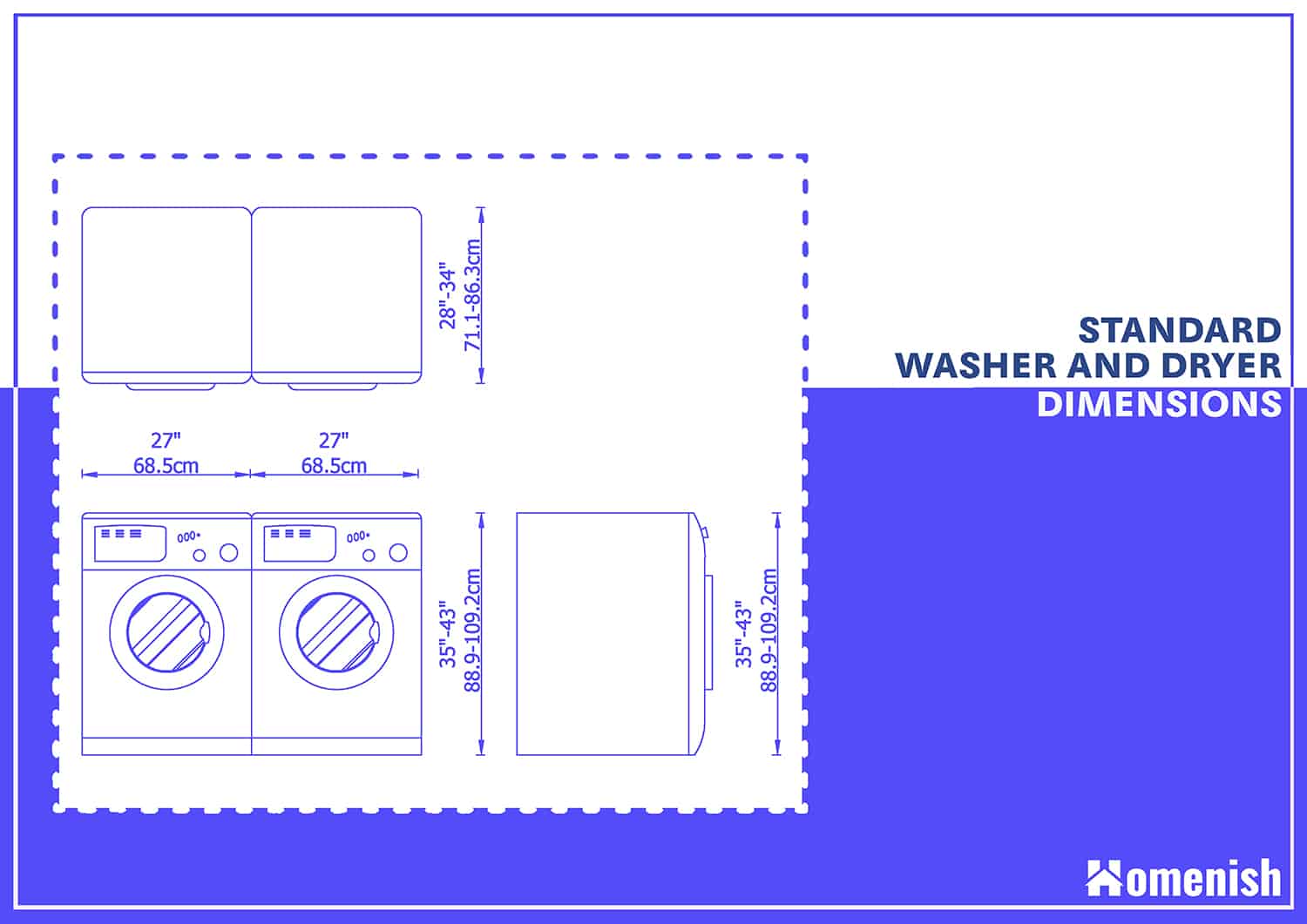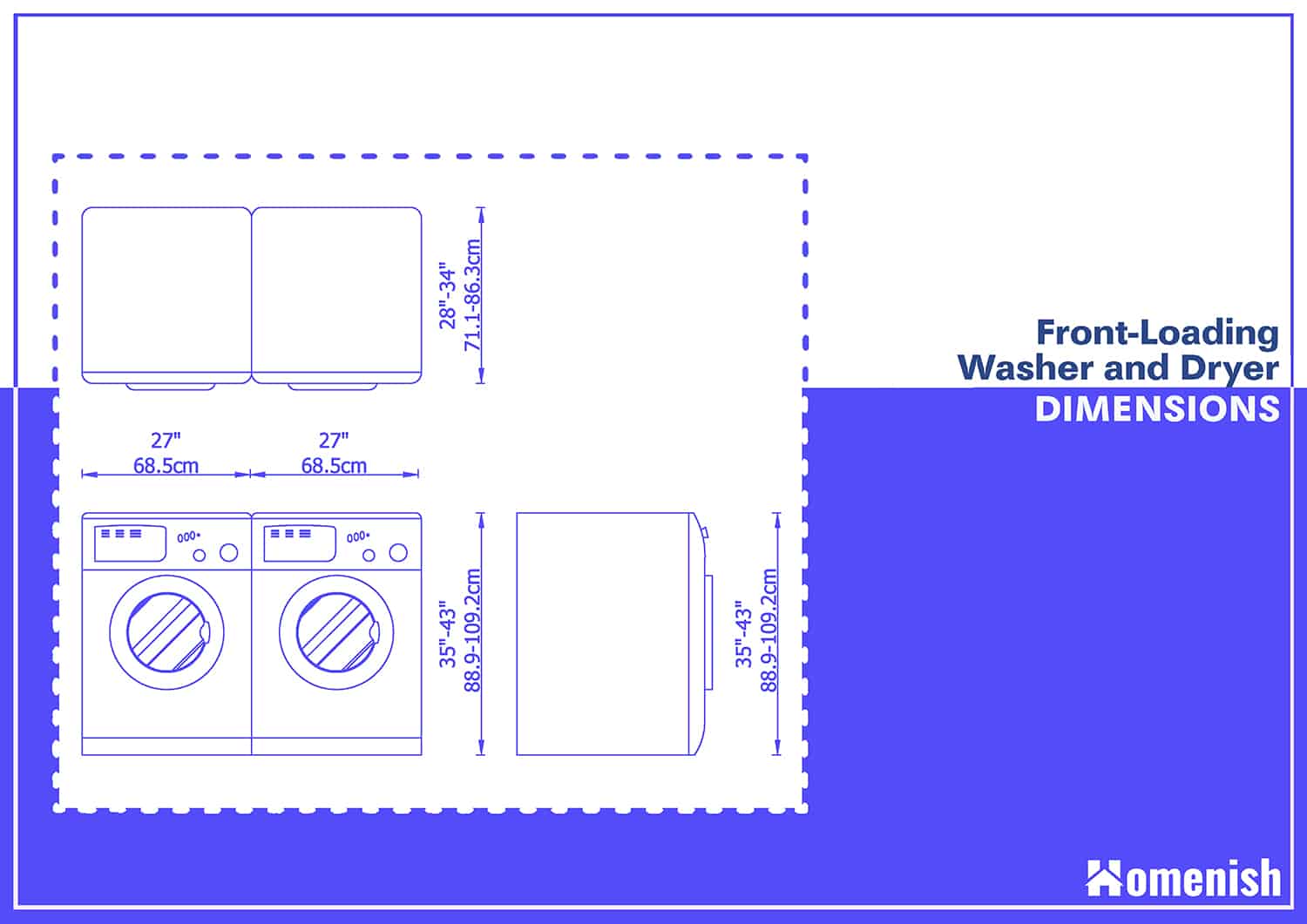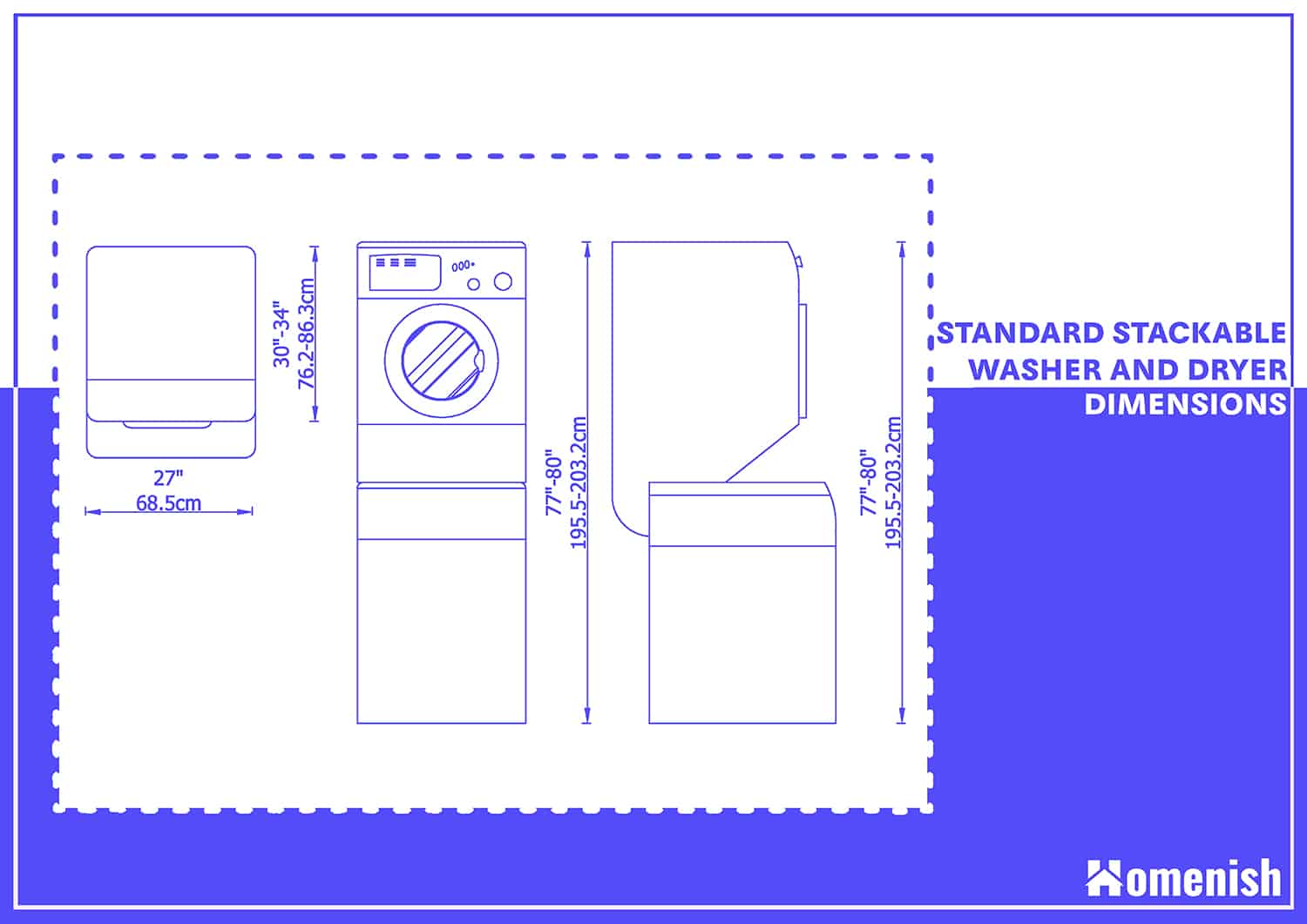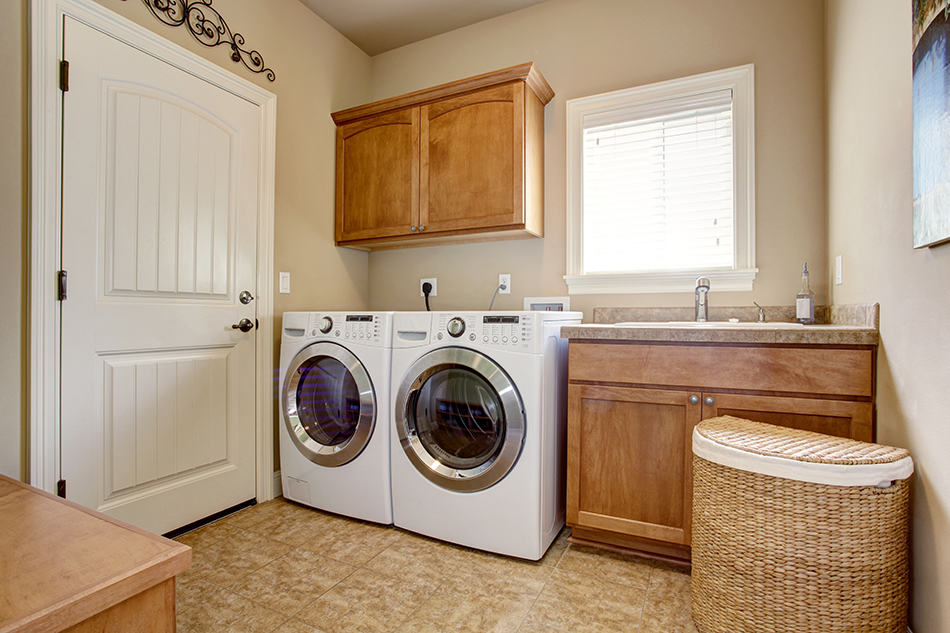The dimensions of a washer and dryer will affect the possible layouts for your laundry room or kitchen, so it’s important to take note of these before making a purchase.
If you’re installing a new washer and dryer into an existing space then it’s vital to thoroughly understand the dimensions in order to make sure they will fit and offer maximum functionality. The standard washer and dryer dimensions are between 35 and 43 inches in height, between 28 and 34 inches in depth, and 27 inches in width.
These dimensions will vary according to the types of washers and dryers, makes, and models. Here we explore the dimensions of various types of washers and dryers so you can decide which option will be best for your space.
Standard Washer And Dryer Dimensions
A washing machine and tumble dryer are essential parts of any modern home. If you are lucky enough to have a separate laundry room, you won’t need to worry about the space occupied by these appliances. However, if you don’t have much space in your home, you may want to consider getting a stackable washer and dryer instead.
The average washers and dryers have a width of 27 inches, so if you plan to place these units side by side, you’ll need around 54 inches of space plus an additional inch between the appliance. Thus, a total of 57 inches of space will be required.
The height of standard washers and dryers should also be considered. This is usually between 35-43 inches.
For depth, standard-size washers and dryers are around 28-34 inches, but you also need to allow an additional 6 inches of clearing space.
Height of Washer and Dryer
The average height of a washer and dryer is between 35 and 43 inches. If you are buying a washer and dryer to install in a kitchen, then the height is really important to ensure a smooth and consistent look across the space. The height of the washer and dryer should be around equal to the height of your kitchen countertops.
This will create a level surface so that the appliances blend into the room more easily. If you’re looking at front-loading washers, then it’s likely this will need to fit beneath a countertop, so understanding the height of the washer in this instance is essential to make sure it can slot into place.
Many types of washers and dryers will have adjustable feet that allow you to alter the height of the appliance, but this is not always the case.
Depth of Washer and Dryer
The average depth of a washer and dryer is between 28 and 34 inches. When measuring your space, it’s important to remember that 6 inches of clearance will be required behind the washer and dryer, so take this into account for depth measurements.
Washers and dryers with a shallow depth do not present an issue since they can be pulled forward to line up with your cabinets, while washers and dryers that are too deep for the space will protrude out and look too big for the space.
Width of Washer and Dryer
The average width of a washer and dryer is 27 inches per appliance. If you are going to install your washer and dryer side by side, you’ll need between 56 and 58 inches of width space. This will accommodate both of the appliances and also allow a few inches of additional space for a gap between the washer and dryer and gaps between the appliances and the walls or kitchen base units.
A closet is a great place to keep a washer and dryer if you lack a laundry room but don’t want these appliances in your kitchen. The minimum space needed for a washer and dryer closet with the appliances positioned side by side is 56 inches wide.
If you opt for front-loading washers and dryers, which can be stacked on top of each other, then the minimum space needed for a washer and dryer closet will be 29 inches. This allows for the width of two appliances stacked on top of each other and an extra inch on each side for airflow and maneuverability.
Front-Loading Washer and Dryer Dimensions
Front-loading washers and dryers have a door on the front for loading and unloading clothes, rather than the more traditional top-loading models.
Front-loading washers and dryers have the same dimensions as the standard units, but since these can be stacked it means you don’t need as much width space in your laundry room or kitchen to house them. By using a stackable dryer set, you can free up floor space for other purposes.
Having front-loading washers and dryers that stack on top of each other can also mean there is less space needed for a washer and dryer closet, so you can utilize a fairly narrow closet and use it as a compact laundry room.
One thing to bear in mind with front-loading washers and dryers is that you must allow at least 24 inches of clearance space in front of the appliances to ensure the door can open freely.
Stackable Washer and Dryer Dimensions
Stackable washers and dryers are becoming increasingly popular, working especially well if you live in a small apartment or condo unit. Stackable washers and dryers take up less floor space compared to separate units.
You can buy sets of washers and dryers which slot together to form one unit, or you can buy individual standalone front-loading washers and dryers which can be stacked on top of each other to achieve the same result.
Stackable washer and dryer units vary by model, but they are typically around 77 to 80 inches tall and 27 inches wide, with a depth of 30 to 34 inches. Individual front-loading washers and dryers, when stacked on top of each other will occupy the same amount of space.
Washer and Dryer Measuring Guide
This measuring guide should help you figure out how much space you’ll need for a perfect fit.
There are a number of ways you can position your units: side by side if they are top-loading or front-loading, or stacked on top of one another. You can even add a pedestal for increased comfort. Stackable units are ideal for space-constrained homes, but you must still assess your space before determining the right style and size washer and dryer unit.
When measuring your space for the right height, width, and depth of appliances, you must also take into account the clearing space and accessibility for loading and unloading your laundry. While there is no set standard washer and dryer size, it is very important to measure your space thoroughly.
In order to fit your units properly, make space all around them as the units require a little breathing space at the front, back, and sides. Allow 4 feet for easy loading, 6 inches for hoses, and 1 inch for each side of the unit as well as extra space for opening and closing the unit.
To determine the total height of your stacked units, add the individual heights of each appliance. The result will give you a good idea of how easy or difficult it will be for you to operate the top unit.
Washer and Dryer Size Considerations
If you’re not sure which type of washer and dryer unit will best suit your laundry room or kitchen, take note of the following:
– For laundry rooms that lack width, a stacked washer and dryer is a better option. The total height of a standard stacked washer and dryer is normally around 75 inches.
– If you are extremely pushed for space, there are compact washers and dryers for the smallest of spaces. Just remember to check the drum capacity as well as the size of such units. As a rule of thumb, you’ll want the biggest possible capacity-to-size ratio. Otherwise, you may have to do more than one load of laundry each day.
– Check how much clearance space you’ll have in front of the washer and dryer after installation. It is best to allow at least 48 inches of space in front of the washer and dryer for easy access.
– Washers and dryers need gaps at either side that serve multiple functions: it allows air to circulate around the units, which is very important for safety reasons. It also reduces noise pollution. If you place your units too close to the wall, they may bang into them during operation and cause too much noise. This is not only irritating for you, but it can also cause damage to the appliances. Always allow adequate space behind, sides, and the front of the machines.
– Most ceiling heights are at least 8 feet or 96 inches. The average height of stackable washers and dryers is around 6.5 feet, which is 78 inches. This gives you plenty of vertical space, thus making such units ideal in most spaces – unless you want to place them in dormer-style rooms.
– If you plan on placing your stackable units in a closet, you must leave adequate room for the closet doors to open and close without colliding with the units.
– Closet doors that open outward or slide are the best solutions for accessing a washer and dryer closet. Just make sure you measure the space between the back wall of the closet in order to determine the closet’s depth.
– Front-loading washer-dryer combos take up significantly less space vertically than stacked units. Many of these appliances are only 33 inches high, but you must add an extra 6 inches of space for the height, 1 inch for the sides, and 5-10 inches for the rear of the appliance.
By taking the above considerations into account, you will have more success in choosing the right-sized washer and dryer.
Stackable Units Vs. Combo Units
Now that you have a better idea of how much space you need for your washer and dryer, let’s talk about which is the right one for you by weighing up the pros and cons of stackable and combo washers and dryers.
Stackable washers and dryers
Pros
- You can save floor space and even hide the units in closets
- Freestanding appliances are flexible as they can be either stacked, unstacked, or side by side
- If one of the units stops working, you can easily replace them
- Available in electric or gas
- Ideal for space-constrained households
Cons
- Front-loading only
- Additional stacking hardware will be necessary
- Requires heavy lifting for installation or repairs
- More expensive than top-loading units
Washer dryer combos
Pros
- Saves both floor and vertical space
- Can be hidden from view in enclosed spaces
- One machine serves as both a washer and dryer
Cons
- Only available in electric
- Not as energy-efficient as separate units
- If the washing or drying function stops working you’ll need to replace the whole unit
Final Thoughts
Whether you want a stackable washer and dryer or a combo unit, the first step is to ensure you have adequate space in your laundry room or kitchen.
This can be done by measuring the depth, width, and height of the installation space before buying the appliances. Be sure to leave enough space to comfortably open and close the doors of your units without any obstructions. Allow at least 4 feet of space for loading and unloading.
Once you understand how much room you have to work with, you can search for the right washer and dryer model.
